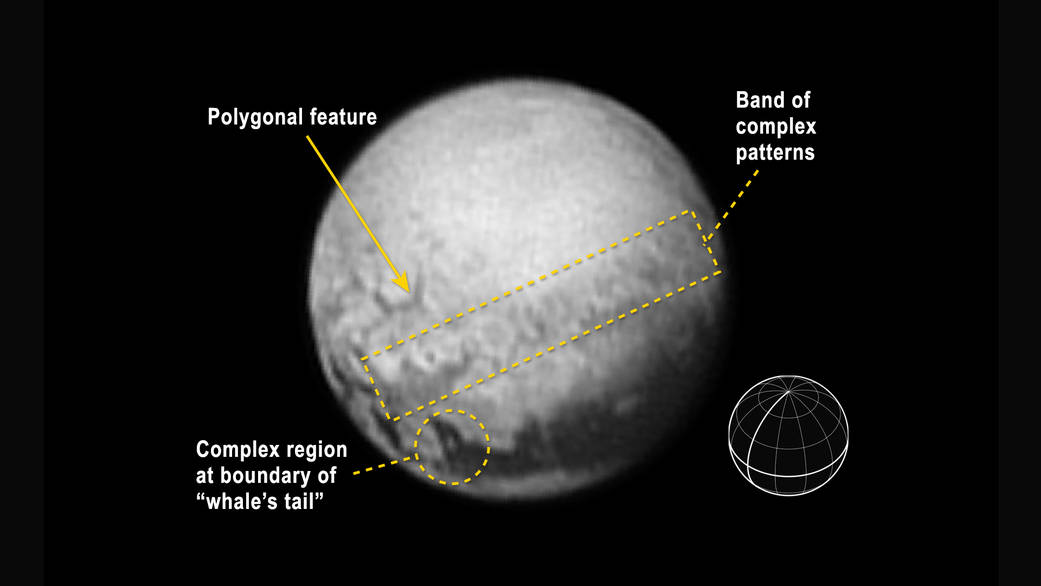It looks like you're using an Ad Blocker.
Please white-list or disable AboveTopSecret.com in your ad-blocking tool.
Thank you.
Some features of ATS will be disabled while you continue to use an ad-blocker.
share:
originally posted by: 0bserver1
As this getting weirder after Ceres Pluto shows polygonal structures and a band of complex patterns. I know we can't run into wild conclusions, but I really starting to get very excited when I read that NASA writes these unknown anomalies such as
Polygonal structure , band of complex structures and complex region of whale's tail
now found on two planets within our own solar system ..
After knowing that on Ceres those bright spots really seems to shine and they have no other scientific model what this could be yet, are we living on the turning point of disclosure?
I know that hexagonal end polygonal structures are common within the universe like we saw on Saturn , but I really like to know how they got formed on ice and stone moons ?
What did they see so stunning when they were viewing this latest image ?
What are we looking at do those four equally spaced spots are polygonal or hexagonal structures . And how can those structures be formed, are there any Pro's or just your imaginational average human being with a bright spectrum of common sense around here that can tell a bit about those structures...
I'm listening..
In a previuos thread, I had mentioned multiple asteroid hits. Just like what hit Jupiter. Now, as the more data comes in, it is more like methane lakes like Titan.
originally posted by: stormcell
I'm guessing Pluto has surface consisting of fractured sheets of frozen gases: nitrogen, methane and carbon dioxide. At those temperatures, rocks would just become brittle and shatter into dust with every meteorite impact. Perhaps gravitational pressure and radioactivity would create internal heat that would allow some underground areas to have a comfortable temperature.
www.spacedaily.com...
There could be lakes of liquid nitrogen, neon and oxygen floating around ice sheets of helium and hydrogen.
Your link mentions nothing about liquid nitrogen/neon/oxygen. It mentions solid nitrogen, though.
The temperature range on pluto is maximum 218 C at the surface. It's actually warmer in the atsmophere, with a maximum of 180 C. The average surface temp is I think 229 C;
An interesting fact is if you were on pluto our sun would still be brigher than our moon, thoughg it'd be 1/900th as bright as it's here.
EDIT: The leading thoght apparently is the dark patches--which resemble lakes to my eyes--are actually hydrocarbon tars which stick to the surface and slowly grow or change. My question is: Could "channels" or lake-like appearnaces be created by a tar which slowly moves over thousands/millions of years? Does it "move" like a tar? For example, I'm picturing in my mind something like lava smipping out of a volcano and moving really slow, creating channels as it falls in elevation. Except this is a tar, not lava. It's not a volcano causing it either--so to speak.
edit on 13-7-2015 by
jonnywhite because: (no reason given)
originally posted by: Kratos40
Now, as the more data comes in, it is more like methane lakes like Titan.
Except Pluto doesn't have a sufficient atmospheric pressure to support bodies of liquid on its surface. The dark patches on Pluto are more like the hydrocarbon dunes on Titan.
Really interesting surface features , but nothing out of the ordinary in terms of natural formations , as other posters have said there are many
geometric shapes in nature even straight edged crystal matrices
Look at Pyrite in matrix they form almost perfect cubes , many other crystals form many geometric shapes and look manufactured
Look at Pyrite in matrix they form almost perfect cubes , many other crystals form many geometric shapes and look manufactured
originally posted by: Kratos40
In a previuos thread, I had mentioned multiple asteroid hits. Just like what hit Jupiter. Now, as the more data comes in, it is more like methane lakes like Titan.
Maybe frozen hydrocarbons rather than liquid hydrocarbons. The dark patches are believed to be frozen hydrocarbon tars.
There had been some speculation a few years ago that if Pluto had flowing liquids, it could be liquid neon, such as rivers of neon. There is no specific evidence to support that; it's just that the potential for liquid neon exists.
originally posted by: sapien82
Really interesting surface features , but nothing out of the ordinary in terms of natural formations , as other posters have said there are many geometric shapes in nature even straight edged crystal matrices
There are hexagonal craters on other bodies in the solar system. Several have bee seen by the Dawn Probe, which has been studying Ceres for the past few months.
As I mentioned in an earlier post, geological fault lines and the formation of impact craters could interact in such a way to result in hexagonal craters.
a reply to: 0bserver1
First there are craters on the Moon that are polygons/hexagons, band of complex patterns, when Mars was looked at through early telescopes it was thought that the dark areas were canals YOU are just doing the same thing seeing what you want to see.
As for the expression on the faces these people are seeing the best IMAGES ever of Pluto and have been waiting 10+ years for them YOU would be excited as well
First there are craters on the Moon that are polygons/hexagons, band of complex patterns, when Mars was looked at through early telescopes it was thought that the dark areas were canals YOU are just doing the same thing seeing what you want to see.
As for the expression on the faces these people are seeing the best IMAGES ever of Pluto and have been waiting 10+ years for them YOU would be excited as well
edit on 13-7-2015 by wmd_2008 because: (no reason given)
originally posted by: Soylent Green Is People
originally posted by: Kratos40
In a previuos thread, I had mentioned multiple asteroid hits. Just like what hit Jupiter. Now, as the more data comes in, it is more like methane lakes like Titan.
Maybe frozen hydrocarbons rather than liquid hydrocarbons. The dark patches are believed to be frozen hydrocarbon tars.
There had been some speculation a few years ago that if Pluto had flowing liquids, it could be liquid neon, such as rivers of neon. There is no specific evidence to support that; it's just that the potential for liquid neon exists.
Could you link anything? I've not seen anyting which supports liquids on Pluto. Wildespace states the atmospheric pressure is too low on Pluto to support it. What do you think about that?
They're most definitely hydrocarbon lakes or frozen dunes. I'd think any liquid would be detected a long time ago because albedo/smoothness.
edit on 13-7-2015 by jonnywhite because: (no reason given)
new topics
top topics
-
Federal law trumps state and local law every time
Social Issues and Civil Unrest: 17 hours ago, 17 flags
active topics
-
Petition Calling for General Election at 564,016 and rising Fast
Political Issues • 94 • : Freeborn -
-@TH3WH17ERABB17- -Q- ---TIME TO SHOW THE WORLD--- -Part- --44--
Dissecting Disinformation • 3384 • : brewtiger123 -
BIDEN Admin Begins Planning For January 2025 Transition to a New President - Today is 4.26.2024.
2024 Elections • 59 • : WeMustCare -
DOJ Special Counsel Robert HUR Says JOE BIDEN Can Be ARRESTED After Jan 20th 2025.
Above Politics • 30 • : WeMustCare -
On Nov. 5th 2024 - AMERICANS Prevented the Complete Destruction of America from Within.
2024 Elections • 160 • : WeMustCare -
Results of the use of the Oreshnik missile system in Dnepropetrovsk
World War Three • 240 • : 777Vader -
Both KAMALA and OBAMA are on the Nov 5th 2024 Ballot - If One Loses - Both Lose.
2024 Elections • 9 • : WeMustCare -
How many people, in GENERAL, are musically inclined?
Music • 26 • : Huronyx -
Well, here we go red lines crossed Biden gives the go ahead to use long range missiles
World War Three • 395 • : annonentity -
Federal law trumps state and local law every time
Social Issues and Civil Unrest • 30 • : ADVISOR


